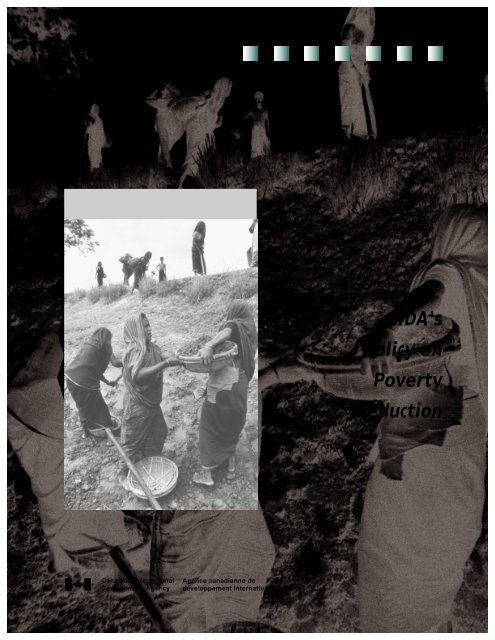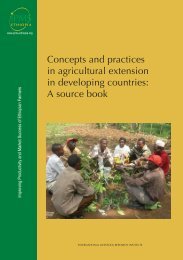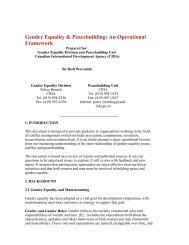CIDA's Policy on Poverty Reduction
Policy on Poverty Red.pdf - Ethiopia-Canada Cooperation Office ...
Policy on Poverty Red.pdf - Ethiopia-Canada Cooperation Office ...
- No tags were found...
You also want an ePaper? Increase the reach of your titles
YUMPU automatically turns print PDFs into web optimized ePapers that Google loves.
<str<strong>on</strong>g>CIDA's</str<strong>on</strong>g><str<strong>on</strong>g>Policy</str<strong>on</strong>g> <strong>on</strong><strong>Poverty</strong>Reducti<strong>on</strong>Canadian Internati<strong>on</strong>alDevelopment AgencyAgence canadienne dedéveloppement internati<strong>on</strong>al
<str<strong>on</strong>g>CIDA's</str<strong>on</strong>g> <str<strong>on</strong>g>Policy</str<strong>on</strong>g> <strong>on</strong><strong>Poverty</strong> Reducti<strong>on</strong>
A. INTRODUCTIONThe Government's foreign policy statement,Canada in the World, released <strong>on</strong> February 7,1995, provides a clear mandate for CanadianOfficial Development Assistance (ODA):"The purpose of Canada's ODA is to supportsustainable development in developingcountries, in order to reduce poverty and toc<strong>on</strong>tribute to a more secure, equitable andprosperous world."Canada's development assistance program recognizesthe vital link between poverty reducti<strong>on</strong> andsustainable development, and is built <strong>on</strong> a broadarray of programs and policies working togetherin an integrated way.<strong>Poverty</strong> results from the lack of human, physicaland financial capital needed to sustain livelihoods,and from inequities in access to, c<strong>on</strong>trolof, and benefits from political, social or ec<strong>on</strong>omicresources. In an interdependent world, povertyin developing countries increasingly affects theec<strong>on</strong>omic, social and political welfare of developedcountries. <strong>Poverty</strong> can lead to serious globalproblems, such as envir<strong>on</strong>mental degradati<strong>on</strong>,political and ec<strong>on</strong>omic instability, and large-scalemigrati<strong>on</strong> of people in search of a better life.In this c<strong>on</strong>text, the policy will provide a frameworkfor poverty reducti<strong>on</strong> and will guide programmingin each of the six programming prioritiesfor ODA: basic human needs; women indevelopment; infrastructure services; humanrights, democracy and good governance; privatesector development; and the envir<strong>on</strong>ment.In addressing the challenges posed by poverty,important distincti<strong>on</strong>s must be made between"relief" and "reducti<strong>on</strong>". <strong>Poverty</strong> relief addressesthe poor's survival needs, their immediate problems,and the effects of inequities. It does notenable the poor to secure or sustain their livelihoods,or to end the <strong>on</strong>going cycle of poverty.<strong>Poverty</strong> reducti<strong>on</strong> is a process by which the causesof deprivati<strong>on</strong> and inequity are addressed.Clearly, "relief" activities can be critical in dealingwith famines and other disasters-- indeed, shorttermsurvival strategies are crucial for theextremely poor. However, the challenge lies inmaking the transiti<strong>on</strong> from the short-termresp<strong>on</strong>se of relief activities to interventi<strong>on</strong>s whichwork to reduce poverty in the l<strong>on</strong>g run.<strong>Poverty</strong> reducti<strong>on</strong> is complex and difficult, anddespite c<strong>on</strong>siderable programming experience inCIDA, it remains a challenge. <str<strong>on</strong>g>CIDA's</str<strong>on</strong>g> approachto poverty reducti<strong>on</strong> will require:◆◆◆a better understanding of the country-specificand local characteristics of poverty;a coordinated use of project, program, instituti<strong>on</strong>alsupport and policy interventi<strong>on</strong>s toachieve maximum impact; anda clear view of <str<strong>on</strong>g>CIDA's</str<strong>on</strong>g> role and capabilities.2
B. POLICY<strong>Poverty</strong> reducti<strong>on</strong> will be a central focus ofCanada's development cooperati<strong>on</strong> program.CIDA will make c<strong>on</strong>certed efforts through itsprograms to c<strong>on</strong>tribute to a sustained reducti<strong>on</strong>both in the number of people living in poverty indeveloping countries, and in the extent of theirdeprivati<strong>on</strong>.(1) An Agency-wide definiti<strong>on</strong> of povertyreducti<strong>on</strong> will be adopted.<strong>Poverty</strong> reducti<strong>on</strong> means a sustained decreasein the number of poor and the extent of theirdeprivati<strong>on</strong>. This requires that the root causesand structural factors of poverty be addressed.Reducing poverty places a focus <strong>on</strong> people's capabilitiesto avoid,or limit, their deprivati<strong>on</strong>. Keyaspects of this are: recognizing and developing thepotential of the poor; increasing their productivecapacity; and reducing barriers limiting theirparticipati<strong>on</strong> in society. <strong>Poverty</strong> reducti<strong>on</strong> mustfocus <strong>on</strong> improving the social, ec<strong>on</strong>omic andenvir<strong>on</strong>mental c<strong>on</strong>diti<strong>on</strong>s of the poor and theiraccess to decisi<strong>on</strong> making.<strong>Poverty</strong>-reducti<strong>on</strong> activities should be carried outin a manner which promotes sustainability, buildsself-reliance, and avoids dependency relati<strong>on</strong>shipsam<strong>on</strong>g d<strong>on</strong>ors, partners, and beneficiaries.(2) <strong>Poverty</strong> profiles and reducti<strong>on</strong> strategieswill be integrated into country or regi<strong>on</strong>alpolicy frameworks. Efforts will be made toensure that the strategies are complementaryto those of recipient countries.A poverty profile analyzes the root causes andc<strong>on</strong>tributing factors of poverty, and places povertywithin a country's ec<strong>on</strong>omic, instituti<strong>on</strong>al andsocial c<strong>on</strong>text. It summarizes informati<strong>on</strong> <strong>on</strong> thesources of income, c<strong>on</strong>sumpti<strong>on</strong> patterns, ec<strong>on</strong>omicactivities, access to services and living c<strong>on</strong>diti<strong>on</strong>sof the poor, and examines how poverty iscorrelated with gender, ethnic and othercharacteristics.A poverty reducti<strong>on</strong> strategy requires an understandingof the specific characteristics of povertyin a country or locality, the requirements forpoverty reducti<strong>on</strong>, and assessments of whereCIDA, given its resources, can have the greatestimpact. CIDA will select activities which workto diminish c<strong>on</strong>straints or improve opportunitiesfor the largest possible number of people. Theidentificati<strong>on</strong> of c<strong>on</strong>straints and opportunitiescomm<strong>on</strong> to a large number of the poor in agroup or country, as well as the selecti<strong>on</strong> of activitiesto reduce poverty, must be d<strong>on</strong>e with the fullparticipati<strong>on</strong> of people, their organizati<strong>on</strong>s andtheir governments.It must be clearly recognized that the scope ofpoverty-reducti<strong>on</strong> activities can occur at the community,local, regi<strong>on</strong>al, nati<strong>on</strong>al and internati<strong>on</strong>allevels because the c<strong>on</strong>straints and opportunitiesfacing different groups of the poor can occur at allthese levels. A clear distincti<strong>on</strong> must be madebetween these levels to address the systemic causesof poverty and to promote effective programming.3
(3) Programming at CIDA will be c<strong>on</strong>sistentwith the goal of poverty reducti<strong>on</strong>.CIDA programming will be assessed with respectto its impact <strong>on</strong> the poor. To be c<strong>on</strong>sistent withthe goal of poverty reducti<strong>on</strong>, programs or projects--evenif they do not directly target the poor--should minimize the negative impacts <strong>on</strong> thepoor, where possible, and exploit complementaritieswhich can also have a positive impact <strong>on</strong> thepoor. (For example, in situati<strong>on</strong>s where privatesector development can help reduce poverty bygenerating income and employment growth,CIDA will assist programs that support localenterprises, particularly microenterprises, cooperatives,and small businesses.)(4) CIDA will c<strong>on</strong>centrate <strong>on</strong> areas where it hasa comparative advantage: this includes bothpoverty-focussed and policy-level interventi<strong>on</strong>s.Although poverty reducti<strong>on</strong> is multifaceted innature, CIDA cannot be "all things to all people".CIDA needs to focus its efforts to find areas ofcomparative advantage where, given its resources,it can make significant interventi<strong>on</strong>s. Strategicinterventi<strong>on</strong>s require an analysis of what <str<strong>on</strong>g>CIDA's</str<strong>on</strong>g>capabilities are and <strong>on</strong> what areas it should c<strong>on</strong>centrate.There must be a c<strong>on</strong>stant search forcomplementarities am<strong>on</strong>g project, program, instituti<strong>on</strong>alsupport and policy interventi<strong>on</strong>s.This means that the target beneficiaries of all programmingwill need to be identified, as well asthose who might face indirect negative repercussi<strong>on</strong>s;that poverty profiles will be used for n<strong>on</strong>povertyinterventi<strong>on</strong>s; and that indicators will bedeveloped to measure the impact of projects.4CIDA Photo: David Barbour
C. PROGRAMMING STRATEGIESIn light of emerging development challenges andless<strong>on</strong>s learned, and to provide a central focus andcoherence across the Agency in its poverty-reducti<strong>on</strong>effort, CIDA will:(1) Address the root causes and structural factorsof poverty:For sustained poverty reducti<strong>on</strong>, the root causesand structural factors of poverty must beaddressed. This places an emphasis <strong>on</strong> improvingthe poor's human and productive capacities, and<strong>on</strong> removing barriers to their participati<strong>on</strong> in society.Thus, a key element to sustained povertyreducti<strong>on</strong> is enabling the poor to secure sustainablelivelihoods.(2) Adopt a multi-level strategy:Approaches to poverty reducti<strong>on</strong> can occur atboth the individual or community level, and atthe systemic level. The first approach worksdirectly with those living in or vulnerable topoverty, and addresses the c<strong>on</strong>straints facing themat an individual or community level (e.g., provisi<strong>on</strong>of assets, training). The latter approachworks at the policy or instituti<strong>on</strong>al level, and seeksto address the broader systemic causes and factorsc<strong>on</strong>tributing to poverty.(3) Use a threefold classificati<strong>on</strong> in addressingpoverty: targeted poverty programs,focussed poverty programs, and policy interventi<strong>on</strong>s.a. Targeted poverty programsTargeted poverty-reducti<strong>on</strong> activities work directlywith the poor to improve their welfare. For aproject to be classified under this category, twocriteria must be satisfied:◆key interventi<strong>on</strong>s must be designed to lead topoverty reducti<strong>on</strong> through the promoti<strong>on</strong> ofsustainable livelihoods and the broader participati<strong>on</strong>of the poor in society.Since 1982, CARE Canada's RuralMaintenance Program in Bangladesh has providedover 60,000 rural women with full-timejobs <strong>on</strong> road crews maintaining a network ofroads across the country--and is now helpingthem start their own businesses.Even though they earn <strong>on</strong>ly a few dollars a week,the jobs provide steady, reliable income for someof the poorest people in <strong>on</strong>e of the poorest countriesin the world.The project has resulted in significant improvementsto the lives of the workers and their families.The women have have been able to improvetheir children's diets and send them off to school--and, <strong>on</strong> the whole, they themselves are healthierand more active in family and community life.A new phase of the project is encouraging womento strike out <strong>on</strong> their own and set up small businesses.They are hired for a four-year period andduring the third year of the program they areenrolled in a compulsory savings program andare given training in basic marketing skills andbusiness management.So far, about 24,000 women have "graduated"from the program and g<strong>on</strong>e into business forthemselves. They have c<strong>on</strong>fidence in themselvesand are respected in their communities.◆the poor must be the specified target group(e.g., destitute women, rural landless); and5
. <strong>Poverty</strong>-focussed programs<strong>Poverty</strong>-focussed activities refer to programs andactivities which benefit the poor, but do notinvolve working directly with them. Examplesinclude:◆ capacity building of organizati<strong>on</strong>s which workwith the poor;◆ instituti<strong>on</strong>al changes to address the needs ofthe poor; and◆ interventi<strong>on</strong>s, such as research into small-scaleagricultural techniques, whichcould be employed by poor farmers.The criteria for programs to be povertyfocussedis that they will disproporti<strong>on</strong>atelybenefit a larger number of poor than n<strong>on</strong>poor.CIDA Photo: David BarbourSince 1988, the Peru-Canada Fund has improvedthe lives of more than a milli<strong>on</strong> poor people in Peruand stimulated the ec<strong>on</strong>omies of hundreds of smalltowns and villages in the most isolated and impoverishedareas of the country.The Peru-Canada Fund is a private, n<strong>on</strong>-profitPeruvian foundati<strong>on</strong> providing support to a widevariety of community self-help projects in Peru'spoorest rural areas and barrios. Using a network ofcommunity and n<strong>on</strong>-governmental organizati<strong>on</strong>s as"catalysts" and project managers, the project hasgenerated jobs, increased agricultural producti<strong>on</strong>,created small businesses and supported themarketing of products.Funding for the community projects is generatedthrough an innovative and highly effective "linesof-credit"program administered by CIDA.Peruvian companies buying Canadian-made equipmentmake their payments directly into the developmentfund. (CIDA pays the Canadian supplier.)Thus, the Peruvian buyers import much-neededCanadian-made equipment--which improves theec<strong>on</strong>omic infrastructure--and provides local currencyfunding for the Peru-Canada Fund.Since its creati<strong>on</strong>, the Fund has financed over 170projects which have directly benefited 1.3 milli<strong>on</strong>poor people. The value of their c<strong>on</strong>tributi<strong>on</strong>--whichis estimated at double the amount of the financingprovided by the Fund--is their ideas and theirlabor.The Peru-Canada Fund has become a model forcooperati<strong>on</strong> programs by other d<strong>on</strong>or countries inthe regi<strong>on</strong>.6
c. <str<strong>on</strong>g>Policy</str<strong>on</strong>g> interventi<strong>on</strong>sActivities which affect the policy envir<strong>on</strong>ment arealso crucial to poverty reducti<strong>on</strong>. Removing systemicc<strong>on</strong>straints at both the nati<strong>on</strong>al and internati<strong>on</strong>allevels can work to address the root causes ofpoverty for both peoples and nati<strong>on</strong>s. Examplesinclude:◆◆◆◆◆the promoti<strong>on</strong> of equitable growth-orientedpolicies;working to reorient public expenditurestowards social priorities;promoting and enshrining property rightswhich are equitable to women;stimulating a nati<strong>on</strong>al dialogue <strong>on</strong> povertyissues; andworking in the internati<strong>on</strong>al policy area toreduce global poverty.As a result of Canada's initiative, a set of recommendati<strong>on</strong>sfor the explicit and systematic c<strong>on</strong>siderati<strong>on</strong> ofgender issues in ec<strong>on</strong>omic reform programs wasendorsed by the most recent SPA plenary meeting inParis in November 1995. Highlights include:• upfr<strong>on</strong>t gender analysis in designing adjustmentoperati<strong>on</strong>s;• protecting and enhancing public expenditures thatfoster gender equity, such as primary educati<strong>on</strong>,basic health services; and• finding ways to increase African women's participati<strong>on</strong>in ec<strong>on</strong>omic decisi<strong>on</strong> making.There is now broad acceptance that effective integrati<strong>on</strong>of gender c<strong>on</strong>cerns into the design and implementati<strong>on</strong>of measures to support ec<strong>on</strong>omic reforms inAfrica can lead to improved results.Canada, through CIDA, is an active participant inthe Special Program of Assistance to the low-incomecountries of sub-Saharan Africa (SPA). This internati<strong>on</strong>alforum of d<strong>on</strong>ors, chaired by the World Bank,coordinates support for ec<strong>on</strong>omic reforms in most ofsub-Saharan Africa.Since it was launched in 1987, the SPA has sent aclear message to Africa and the rest of the world: thereis a vital link between good ec<strong>on</strong>omic policy andpoverty reducti<strong>on</strong>.Significant progress has been made in highlighting theimportance of "gender equity"--recogniti<strong>on</strong> that menand women are affected differently by ec<strong>on</strong>omicreforms. African women, for example, do the bulk offarming and trading, but are c<strong>on</strong>strained in theirability to resp<strong>on</strong>d to new ec<strong>on</strong>omic incentives, due tofactors such as limited access to credit and appropriateagricultural extensi<strong>on</strong> services, an already heavy workload,etc. With the acceptance by the SPA that gendershould be recognized as an important part of theadjustment agenda, Canada established the StructuralAdjustment and Gender in Africa initiative--or"SAGA"-- a collaborative framework for SPA d<strong>on</strong>orsand working groups.7
(4) Combine ec<strong>on</strong>omic growth and socialinvestments:There is no automatic link between ec<strong>on</strong>omicgrowth and poverty reducti<strong>on</strong>. Ec<strong>on</strong>omic growthreduces poverty when the productive capacity ofthe poor is matched with the physical locati<strong>on</strong>and the labour needs of the growth sectors.Sound ec<strong>on</strong>omic management, openness todomestic and internati<strong>on</strong>al trade and investments,private sector development, investment in infrastructureservices and in social sectors to meetbasic needs, have been key elements of nati<strong>on</strong>alpolicies which have strengthened the positivelinks between ec<strong>on</strong>omic growth and povertyreducti<strong>on</strong>.Nati<strong>on</strong>al governments and political leadershipcommitted to poverty reducti<strong>on</strong> play a criticalrole. The c<strong>on</strong>diti<strong>on</strong>s established by governments'ec<strong>on</strong>omic and social policies are crucial to thel<strong>on</strong>g-term sustainability of poverty-reducti<strong>on</strong>measures. Governments determine the ec<strong>on</strong>omicpolicy framework, redistribute resources, providecritical social investments for the poor, and framethe legislati<strong>on</strong> that establishes property rights andthe legal basis for removing gender inequities.(5) Address basic human needs:Addressing priorities such as basic educati<strong>on</strong>, primaryhealth care, nutriti<strong>on</strong> and family planning,water and sanitati<strong>on</strong>, and shelter, play a key role inpoverty reducti<strong>on</strong>. Educati<strong>on</strong>, particularly basiceducati<strong>on</strong>, has significant benefits for the poor byincreasing incomes; it also promotes participati<strong>on</strong>by educating people <strong>on</strong> social issues. Educatinggirls is, in particular, the single most effectivedevelopment investment.(6) Achieve food security:Food security allows people to protect and sustaintheir broader livelihoods--while food insecuritycan lead to powerlessness, dependency, pain, andreduced physical and intellectual growth. Foodinsecurity reinforces the cycle of poverty.CIDA will take steps to ensure that food aid isc<strong>on</strong>sistent with, and better integrated into, overallpoverty-reducti<strong>on</strong> and food-security programmingstrategies.Project and program food aid, which is used as adelivery channel for bilateral programming, mustbe explicitly integrated into overall programmingstrategies to increase effectiveness. Food aid mustbe recognized as <strong>on</strong>ly <strong>on</strong>e aspect of food securityand poverty reducti<strong>on</strong>, and must be closely integratedwith other development inputs and programs.However, given the nature of relief activities andthe countries in which they take place, there maynot be country development policy frameworkstrategies available for emergency food aid programs.This is because strategies are <strong>on</strong>ly d<strong>on</strong>e forcountries which are core-funded. In such cases,the development of food-security strategies andthe choice of partners will be crucial. It is criticalthat Canada work with partners who will be presentto work <strong>on</strong> the transiti<strong>on</strong>al and rehabilitativeneeds, bey<strong>on</strong>d the immediate relief requirements.(7) Promote participatory approaches: buildnetworks and involve governments:Supporting the work of local n<strong>on</strong>-governmentalorganizati<strong>on</strong>s (NGOs) and the internati<strong>on</strong>alfinancial instituti<strong>on</strong>s (IFIs) is an area in whichCIDA will c<strong>on</strong>tinue to make a c<strong>on</strong>tributi<strong>on</strong>.8
CIDA can operate at a much smaller scale thanthe IFIs, more c<strong>on</strong>sistent with smaller absorptivecapacities in many countries and areas.Working with recipient governments in buildingnati<strong>on</strong>al approaches to poverty reducti<strong>on</strong> is vital.For example, CIDA can assist countries in developinganti-poverty acti<strong>on</strong> plans by building <strong>on</strong>existing strategies for the provisi<strong>on</strong> of basic educati<strong>on</strong>,primary health care, and improving the welfareof children. This can also facilitate d<strong>on</strong>orcoordinati<strong>on</strong> if d<strong>on</strong>ors are placing their activitiesin overall country frameworks for addressingpoverty.To further promote participatory development,CIDA will:a. Enable people to realize their own capacitiesand goals through participatory processes:Growth, through industrializati<strong>on</strong> and modernizati<strong>on</strong>can marginalize the poor if they are notable to participate in, or be integrated into, technologicalproducti<strong>on</strong> processes. Political and ec<strong>on</strong>omicparticipati<strong>on</strong> in society is essential for theempowerment of the poor and sustained povertyreducti<strong>on</strong>, and enabling the poor to participate inemerging opportunities is crucial.c. C<strong>on</strong>tribute to d<strong>on</strong>or coordinati<strong>on</strong> mechanisms.With increasing d<strong>on</strong>or interest in poverty reducti<strong>on</strong>activities, the need for c<strong>on</strong>sultati<strong>on</strong> and coordinati<strong>on</strong>becomes paramount. CIDA, in c<strong>on</strong>juncti<strong>on</strong>with like-minded d<strong>on</strong>ors, will take a leadin harm<strong>on</strong>izing projects and interventi<strong>on</strong>s withc<strong>on</strong>flicting goals. This is particularly important inintegrating short- and l<strong>on</strong>g-term objectives and inpromoting relief-reducti<strong>on</strong> transiti<strong>on</strong>s.d. Support capacity building and instituti<strong>on</strong>alstrengthening of various groups andorganizati<strong>on</strong>s.Developing the capacity of peoples and countriesto reduce poverty themselves is central to sustainedpoverty reducti<strong>on</strong>. To achieve this, CIDAwill work actively in assisting the capacity andinstituti<strong>on</strong> building of NGOs, governmentdepartments, administrati<strong>on</strong> and research bodies.Whether at the community or nati<strong>on</strong>al level, sustainableinterventi<strong>on</strong>s will require both the commitmentand the capacity of the developing country.b. Implement policies and programming toaddress the gender-poverty nexus.CIDA is recognized as an internati<strong>on</strong>al leader inpromoting and addressing women in development(WID) and gender equity issues. However,although the Agency has traditi<strong>on</strong>ally worked atthe targeted level, experience indicates that to besuccessful, programming must also address theroot causes of gender inequities. CIDA will c<strong>on</strong>tributeto both the policy and programmingstrategies of addressing the gender-poverty nexus.CIDA Photo: Patricia Baeza8
D. MONITORINGCIDA will prepare periodic progress reports outlining achievements, progress in implementati<strong>on</strong>, and priorityacti<strong>on</strong>s for the following period. A formal evaluati<strong>on</strong> of the policy will be c<strong>on</strong>ducted within five years.CIDA Photo: Roger LeMoyne10





